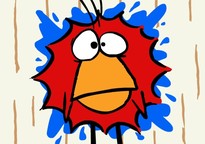Provide white paper, red, yellow, and blue tempera paints, a small paintbrush, paper towels or rags, and a small cup of water for cleaning the brushes.
Show your child some basics about how to change colors, like how to clean a brush in the water and wipe it on the paper towel. Give your child time to explore with the paints and ask if she is getting any colors that she didn't have to begin with.
According to how she responds, ask more specific questions like, "How did you make orange?" or "Where did the green come from?"
For older preschoolers, a nice extension is a color mixing activity using small amounts of food coloring, eyedroppers, and water.
This activity requires some preparation. Fill one cube of a white ice cube tray with colored water (either red, blue, or yellow). Give your child an eyedropper and a small cup of water. Show the child how to use the eyedropper and let him explore a single color by dropping drops of color and drops of water into the empty cubes.
When he has exhausted shades of one color, provide a clean tray with two colors. This will allow the child to create many different subtle shades of each color, as well as many shades of color that result when two colors are mixed. Then, provide a tray with three colors.

 Español
Español









